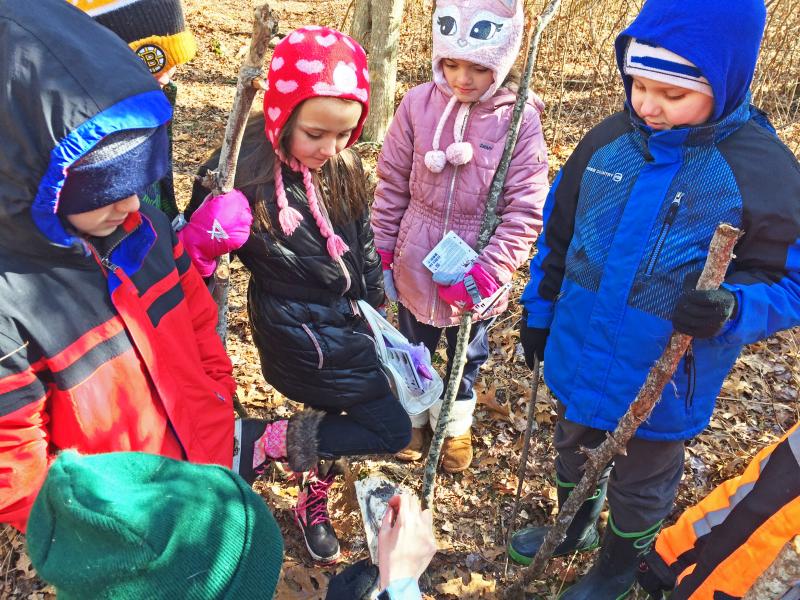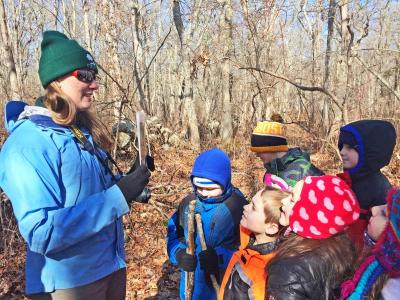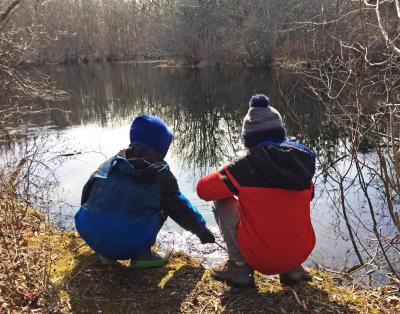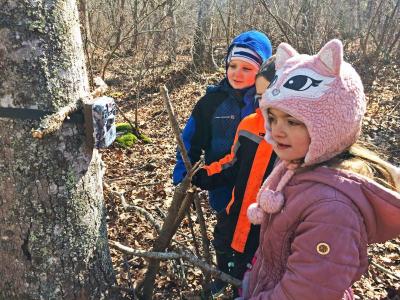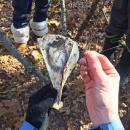Tracking trek: Local kids look for wildlife on school vacation
Did you know that a dog’s paw print usually has nail marks, while a coyote’s usually does not? Or that all Eastern coyotes are coyote-wolf hybrids, so the coywolf is a misnomer?
Several families turned up despite the cold on Thursday morning to learn all these facts and more at a wildlife tracking walk at Smith Neck Farm.
Dartmouth Natural Resources Trust Land Steward Leah Howard walked participants through the woodland property, telling them about coywolves, fox scat, and how to tell the difference between canine and feline tracks by the shape of the paw print (cats have a trapezoidal, not a triangular, center pad.)
Since Howard — a Maine native — realized that snow may not be in the cards in Southern New England this year, she put up game cameras last month to show photos of the animals visiting the property.
“I came up with the idea [for a school vacation activity] because I grew up tracking with my dad in the wintertime,” said Howard. “There isn’t any snow, but there are some muddy areas!”
“My dad grew up in Raynham, and the winter stories that he told me are definitely not what I’m experiencing here now,” she added. “Like, he grew up ice skating on cranberry bogs and making snow forts and stuff.”
But the lack of snow did little to dampen participants’ spirits.
During the walk Howard pointed out game trails and various types of dens in the bases of trees, as well as fox scat on a log (foxes prefer pooping on raised areas like logs, tree stumps, or rocks.)
The kids even found a deer scapula, or shoulder blade bone, with hair still clinging to it, which Howard suspected came from a coyote kill.
Among the animals captured on the cameras were deer, squirrels, raccoons, fisher cats, and coyotes.
Howard had been looking out for bobcat, she said, as there have been sightings as far south as Rhode Island, but so far none have shown up in Dartmouth.
Part of the tour included a skunk-smelling lure on a stick, which drew plenty of predators — especially fisher cats — for the game camera.
When Howard showed one fisher cat photo, the children squealed. “He’s hugging it!” shrieked one impressed youngster.
Eight-year-old Noah Rock of Dartmouth said that he was enjoying the walk. “I like learning about nature because I want to be a zoologist when I grow up,” he said matter-of-factly.
When asked about his favorite animal, Rock pondered before responding, “All of them.”
“He loves being outdoors,” said grandmother Ana Cabral, also of Dartmouth. “Nature, the ocean. Anything to do with outside.”
As for the coywolves, Howard noted, “It’s kind of a pet peeve of mine.”
She explained that a decline in the eastern grey wolf population due to extensive hunting created a niche for coyotes to move in from their native western habitats and intermingle.
So all coyotes in the area, she said, are really coywolves.
“If you’re worried about putting your dogs outside, just go with them,” she added. “Don’t leave them out alone at night. And turn on the lights. Coyotes hate lights.”



